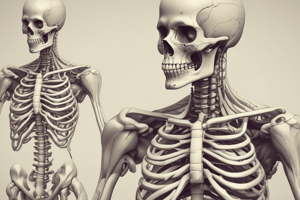Podcast
Questions and Answers
Name three functions of the skeletal system.
Name three functions of the skeletal system.
Protection, support, movement
What is the anatomical name for the shaft of a long bone?
What is the anatomical name for the shaft of a long bone?
Diaphysis
What are the ends of a long bone called?
What are the ends of a long bone called?
Epiphysis
What is yellow marrow?
What is yellow marrow?
How do spongy and compact bone look different?
How do spongy and compact bone look different?
Why do bone injuries heal much more rapidly than injuries to cartilage?
Why do bone injuries heal much more rapidly than injuries to cartilage?
Compare and contrast the role of PTH (hormone) and mechanical forces acting on the skeleton in bone remodeling.
Compare and contrast the role of PTH (hormone) and mechanical forces acting on the skeleton in bone remodeling.
Define fracture.
Define fracture.
Which fracture types are most common in the elderly?
Which fracture types are most common in the elderly?
Why are greenstick fractures more common in children?
Why are greenstick fractures more common in children?
Name the three major parts of the cranium.
Name the three major parts of the cranium.
Name the eight bones of the cranium.
Name the eight bones of the cranium.
What bones are connected by the coronal suture?
What bones are connected by the coronal suture?
What bones are connected by the sagittal suture?
What bones are connected by the sagittal suture?
What is the exception to all skull bones being joined by sutures?
What is the exception to all skull bones being joined by sutures?
What facial bone forms the chin?
What facial bone forms the chin?
What is the cheekbone?
What is the cheekbone?
Name two ways in which the fetal skull differs from the adult skull.
Name two ways in which the fetal skull differs from the adult skull.
Name the five major regions of the vertebral column.
Name the five major regions of the vertebral column.
What is the function of the intervertebral discs?
What is the function of the intervertebral discs?
Name the major components of the thorax.
Name the major components of the thorax.
What is a true rib?
What is a true rib?
What is a false rib?
What is a false rib?
Is a floating rib a true or a false rib?
Is a floating rib a true or a false rib?
Why are floating ribs easily broken?
Why are floating ribs easily broken?
Name the bones of the shoulder girdle.
Name the bones of the shoulder girdle.
Name all the bones with which the ulna articulates.
Name all the bones with which the ulna articulates.
Flashcards are hidden until you start studying
Study Notes
Functions of the Skeletal System
- The skeletal system provides protection, support, and facilitates movement.
- It helps in shaping the body.
Anatomy of Long Bones
- The shaft of a long bone is called the diaphysis, while the ends are known as epiphysis.
- Yellow marrow, rich in fat cells, is responsible for blood cell development.
- Compact bone appears smooth and dense, whereas spongy bone has a porous structure with small needle-like pieces.
Bone Injury Recovery
- Bone injuries heal faster than cartilage injuries due to cartilage's limited blood supply.
Bone Remodeling
- Parathyroid hormone (PTH) regulates bone remodeling based on calcium ion levels in the blood.
Fractures
- A fracture is defined as the cracking or breaking of bone material.
- Comminuted and compression fractures are most common in the elderly.
- Greenstick fractures occur more frequently in children because their bones are more flexible.
Cranium Structure
- The cranium consists of three major parts: support, protection, and movement.
- It is composed of eight bones: ethmoid, frontal, occipital, two parietals, sphenoid, and two temporals.
Sutures of the Skull
- The coronal suture connects the frontal, parietal, temporal, and occipital bones.
- The sagittal suture is between the two parietal bones.
Skull Bone Connections
- Most skull bones are connected by interlocking sutures, with exceptions being the paired parietal and temporal bones.
Facial Bones
- The mandible forms the chin and supports the lower teeth, while the maxilla holds the upper teeth.
Fetal vs. Adult Skull
- The fetal skull is characterized by its thinner bones and the presence of fontanels (soft spots).
Regions of the Vertebral Column
- The vertebral column is divided into five major regions: cervical, thoracic, lumbar, sacral, and coccygeal.
Spinal Curvatures
- Normal spinal curvatures differ from those seen in conditions like scoliosis and lordosis (visual representation required).
Intervertebral Discs
- Intervertebral discs act as shock absorbers, maintaining separation between vertebrae to protect spinal nerves.
Thoracic Skeleton
- The thoracic skeleton consists of ribs and the sternum, categorized as true and false ribs.
- Ribs are numbered from 1 to 12 in ascending order.
Rib Classification
- True ribs directly attach to the sternum, while false ribs do not.
- Floating ribs are considered false ribs and are prone to fracture due to their lack of stable attachment and thin bone structure.
Shoulder Girdle
- The shoulder girdle is composed of the clavicle and scapula in humans. Some species may include a coracoid bone.
Ulna Articulation
- The ulna articulates with the trochlea of the humerus at the elbow, the radius near the elbow for pronation, and the distal radius.
Studying That Suits You
Use AI to generate personalized quizzes and flashcards to suit your learning preferences.




